TOXIGENICITY OF SNAKE VENOM: dangers of ligating (tying) site of snake bite
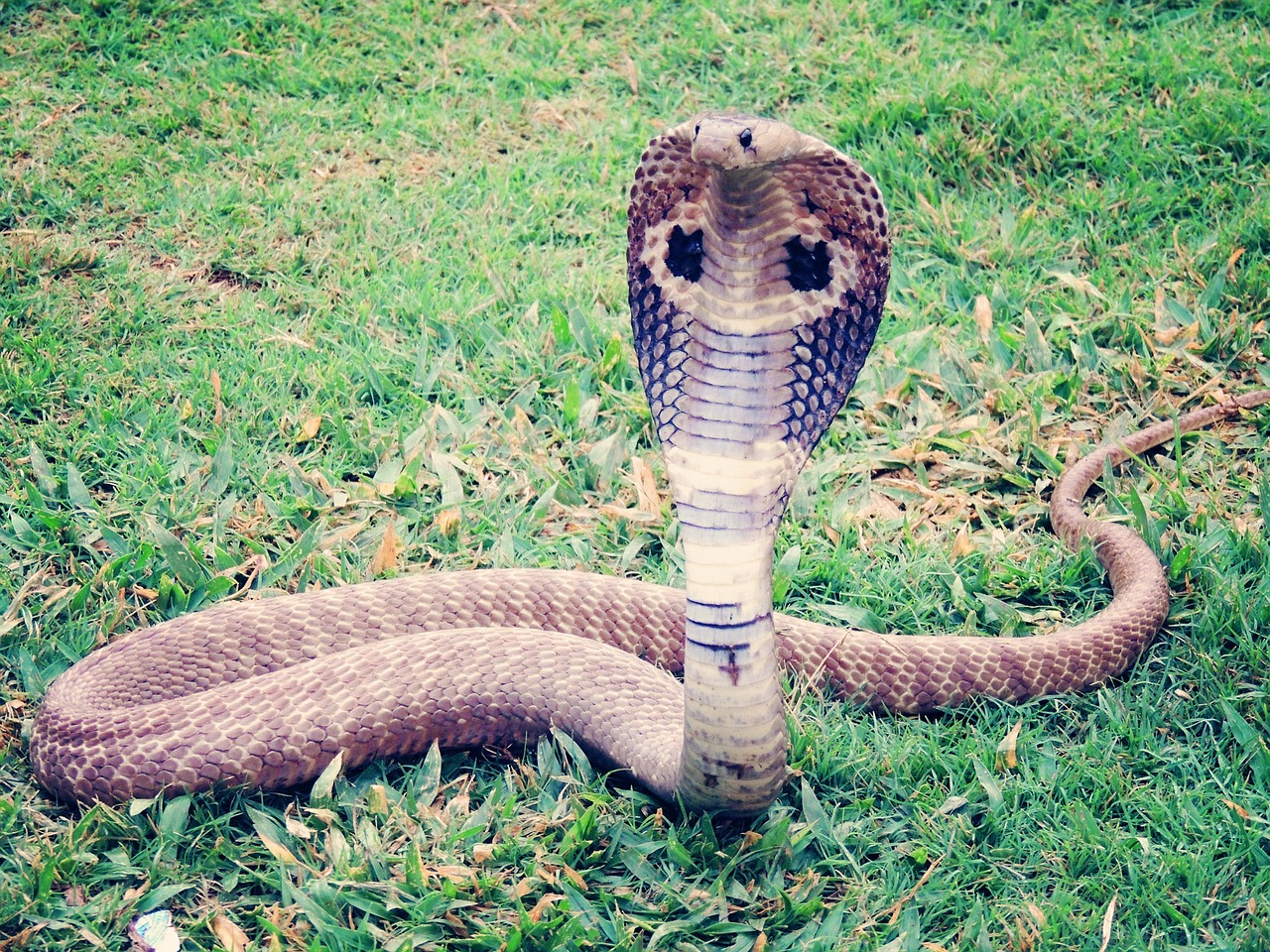
Introduction
It is a common practice in developing countries and some part of the world, whenever a person is bitten by a snake, the first thing that is done is to ligate (tie) the area of the bite as a first aid prior sucking out the venom with their mouth. Most times this is effective and a life saver for the victim but the danger associated with this practice outweighs the advantages of the procedure.
General overview about snakes
Snakes are generally classified as reptiles and they are the egg laying animals, cold blooded and thus always hide under rocks , Stones and in holes so as to maintain the normal physiologic and homeostatic condition of their body. Some snakes live on land while some live in water but majority spend their life on land.
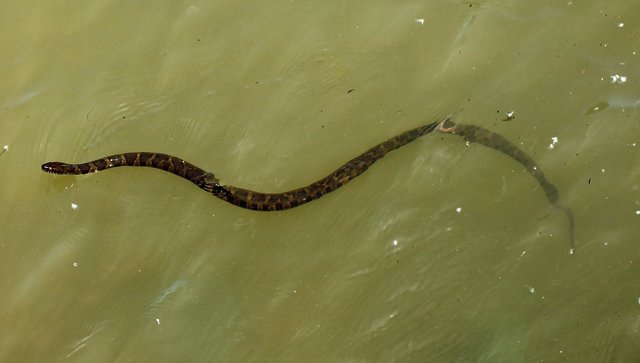
Contrary to the believe of many people, I wish to intimate you that not all snakes are venomous and thus are not harmful.
Most animals have been created in such a way that they are equipped with a very powerful defensive mechanism with which they use to feed, harm or escape the clutches of their predator when they sense danger.
There are very deadly ones like the rattle snake (it announces itself while coming due to the rattling noise made by the structure at its tail end)
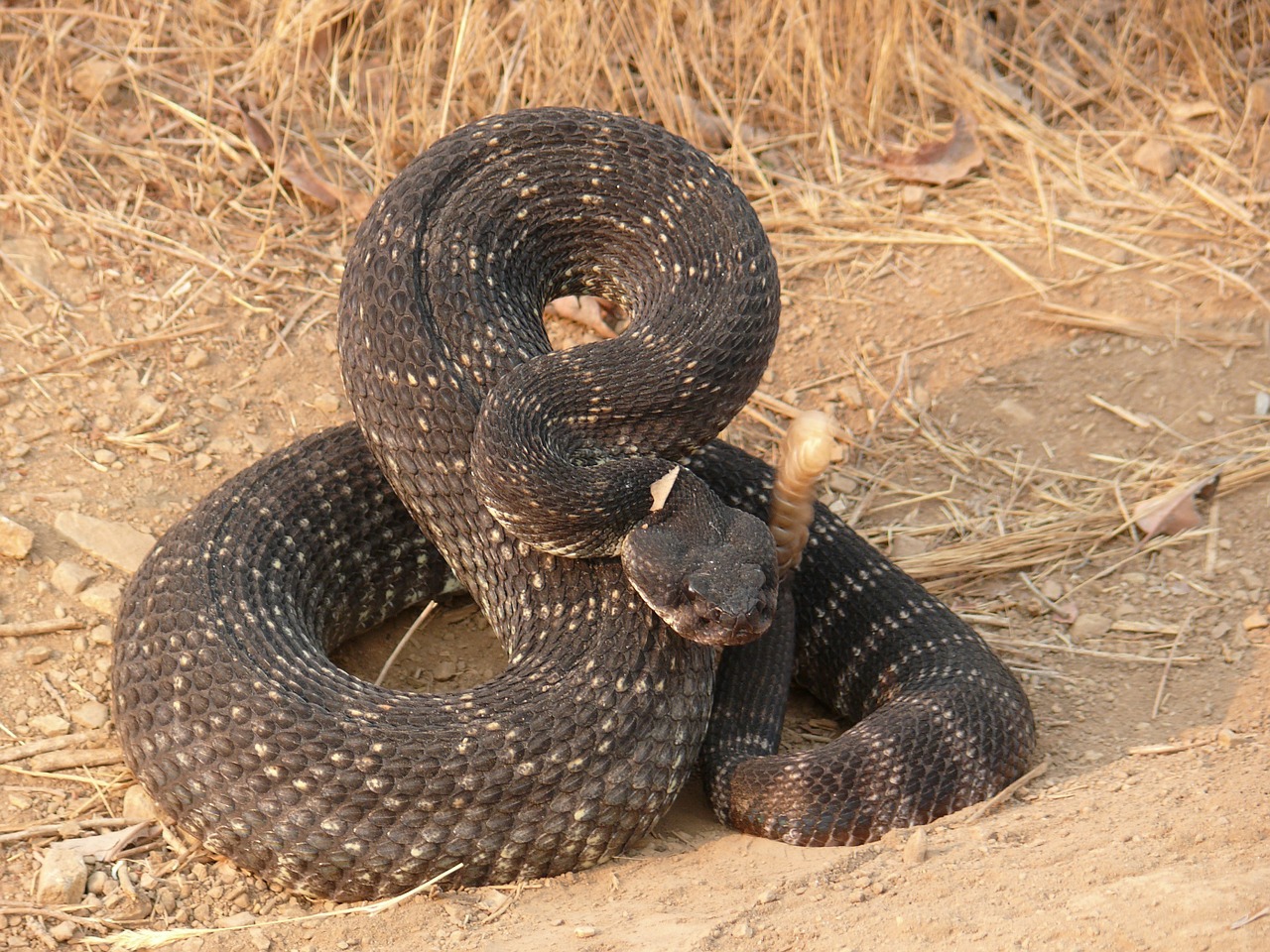
king cobra (the wise but deadly one, it can stand like a praying mantis ready to strike

Others include the vipers, death adders, the sea snakes and the black mamba . There are a whole lot of them found in several continent of the world and they all vary based on several attributes.
Snake venom
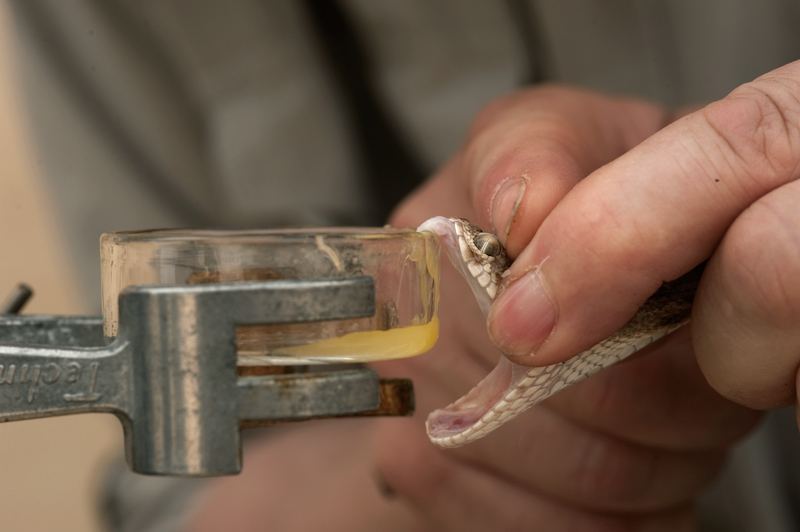
wikimedia commons image by Kalyan Varma source
It is interesting to know that, the most virulent factor and defensive machinery possessed by the harmful snake is their venomous bite aside this they are almost powerless. It can also be stated here that these venom also helps the snake to survive. They need this venom to kill their prey during feeding.
Those that don't produce venom do not most times have fangs and are able to kill by winding around their host suffocating and crushing them to death. An example is the python.
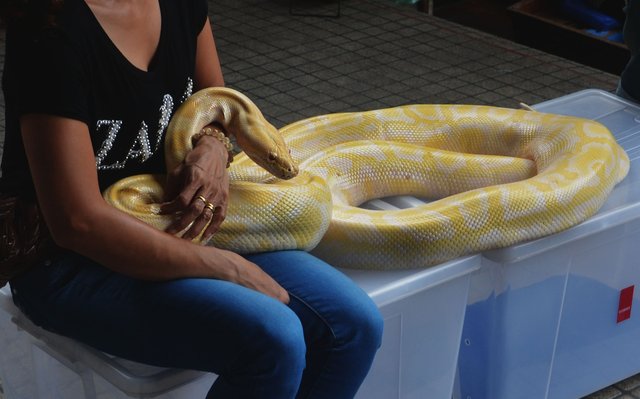
Snake Venoms are poisonous polypeptide proteins produced and secreted by venomous snakes and this venom are usually injected into their host simultaneously when they bite with their fangs.
Some snakes spit out their venom, example is the spitting cobra.
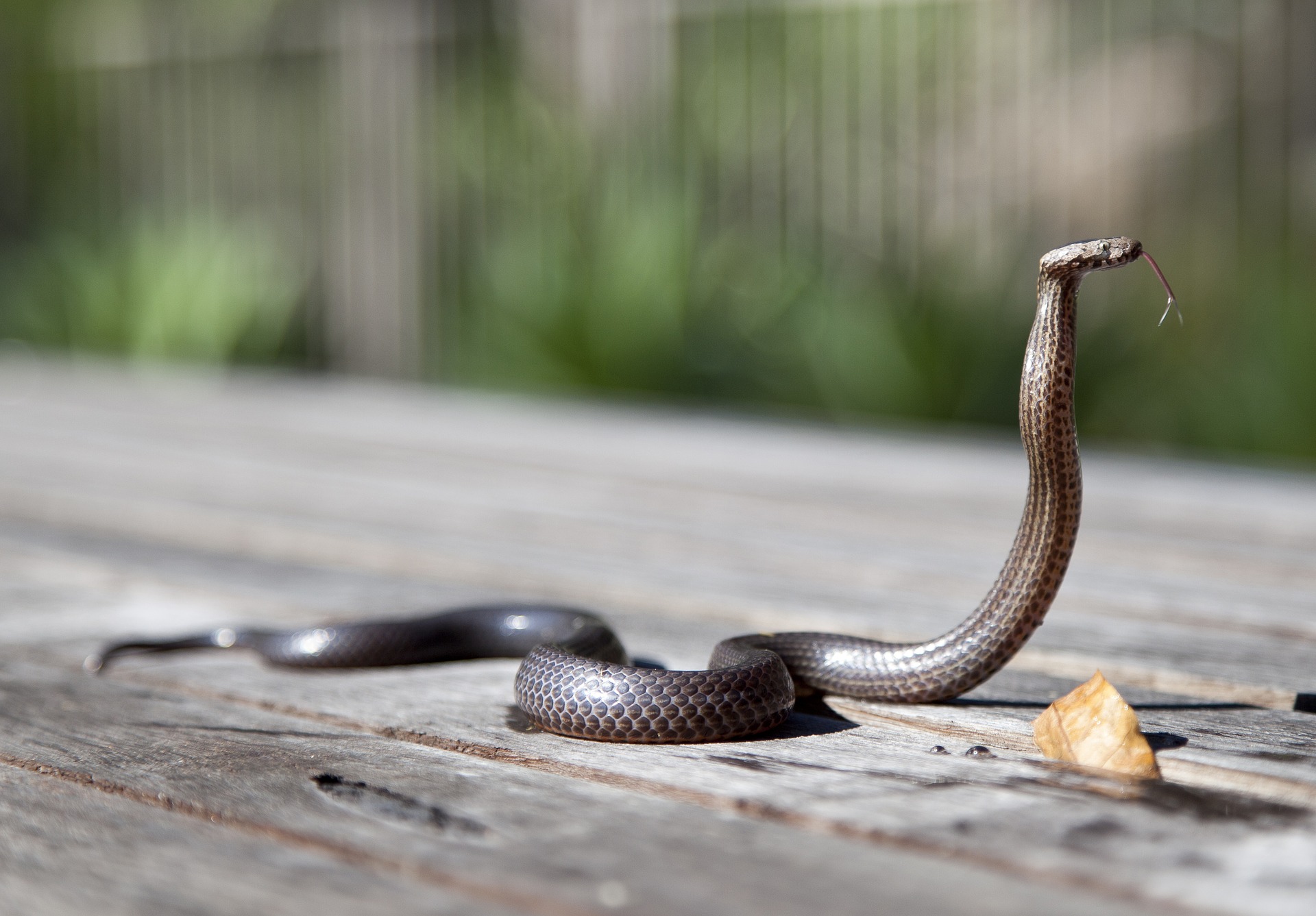
This is usually a defensive mechanism especially when they sense danger and they usually aim for the eyes of their victims. If the venom comes in contact with the cornea of the eyes it can cause blindness if not washed away immediately with plenty of water.
Mechanism of action
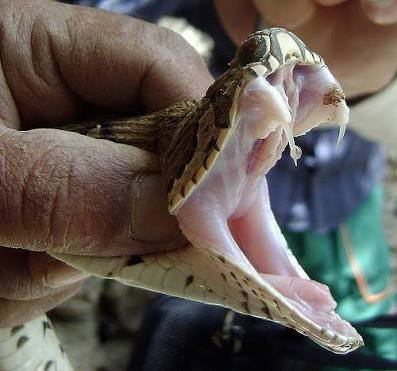.jpeg)
Flickr image by Usman Ahmad under CC BY-SA 2.0 source
These venom when injected elicit an immunogenic reaction in the host and thus leads to allergy or inflammation in the body of the host and around the site of bite. This is usually evident at the site of bite which is often swollen. There is also infiltration of inflammatory cells (neutrophils, eosinpphils,basophil etc) through a process known as diapedesis. Snake bite cause a lot of devastating physiologic effect on human body through there mechanism of actions and these includes :
•some contain enzymes which can either activate Hageman factor 12 of the intrinsic coagulation cascade pathway thus causing disseminated intravascular clotting or deactivate this pathway resulting to continuous bleeding at the site of bite, and this can lead to death of the victim. This is evident in rattlesnake bite.
• some produce nerve toxins that block the neuromuscular system I.e acetycholine thus leading to paralysis, this is also evident in rattle snakebite and black mambas.
•some affect the normal functions of the organs in the body like kidney, liver and heart. When important organ like the kidney is affected, acute renal failure may set in and this ultimately prevents it from carrying out its normal function of producing urine to remove wastes, causing a slow painful death if not treated. This is evident in black mamba and cobra bites.

•some components of these venom cause blood vessel wall to leak and this causes fluid to accumulate in tissue thereby causing painful swelling and edema.
•some also contain peptides that mostly will activate the pain nerve receptors (nociceptors) causing local and generalised pain in the body of the victim.
•some can as well contain proteins that damages the skin, muscle and other tissues of the body resulting to destruction to the hands, legs, feels and arms.
Danger of ligating the area of bite
Haven stated all the necessary attributes and patophysiologic mechanism through which snake bite can cause deleterious effect on human, I find it safe and pertinent to now explain why ligating (tieing) the site of a snake bite need not be done.
The general feature of a snake bite be it venomous or non venomous bite is swelling at the site with two holes (a distinctive feature.
Ligating the site of bite will cause an increased pressure build up at the area under ligation so that when when you finally untie the the tourniquet used on getting to the hospital or health facility, the pressure that has already built up will force these venoms accumulated around this region faster and more quicker to the heart through the blood. This pressure will accelerate the speed at which the venom gets to the heart. If this venom gets to the heart, it will ultimately damage the muscles and consequently cause cardiac heart failures which is fatal.
Secondly, ligating the area of snake bite can cause tissue hypoxia and ischaemia ( a condition in which a tissue is deprived of oxygen and blood respectively). The ligation prevent the flow of blood to the affected area. When the muscle tissue is deprive of oxygen for a long time, this results to muscle atrophy (muscle wasting) leading to death (necrosis) of the muscle tissues. The resultant effect of this is the inability of the victim to use the area of the body affected.
Suggested actions to take before or after a snake bite
•Injection of Antivenoms
There are basically two types of antivenoms
•monovalent and
•Polyvalent anti venom
The monovalent anti venom as the name implies is usually used if one is sure of the identity of the snake that bit such person while the polyvalent is used when one is not sure of the type of the snake.
•Rather than ligating the area of bite, it is recommended to apply pressure bandage if available, this will slow down the movement of the lymphatic fluids which also carries the venom round the body.
•try as much as possible not to panic, panicking will only increase the sympathetic mechanism of the body thus increasing the heart rate, once heart rate is increased, the venom will be delivered faster to the heart. So it is necessary to remain calm and gently call for help.
•it is important to identify the type of snake that bite you if possible. This will enable the doctor or health personal to know the kind of antivenom to be administered.
•it is usually not recommended to suck snake bites, this is because a slight cut or injury in the mouth is enough to allow the venom get into the blood circulation of the individual carrying out the action thus leading to a more serious case than that of the primary victim as it is easier for the venom to get to the brain since the person is sucking through the mouth.
This results to a situation where a doctors now becomes a patient
•it is usually recommended to have polyvalent antivenoms if one is going into the bush or places dominated by snakes. This antivenom should be stored in the freezer at homes should there be any need for it's usage. You should as well wear protective boots while going into the bush. The usual site of snake bite is mostly on the leg and sometimes on the forearm.
Knowing or having an idea of the specie of snake that is prevalent in an area is also important, this will help and ease treatment of the victim.
Conclusion
It is very important that as an act of safety, Every home should have anti venom stored and kept in the freezer. This could be a life saver for someone one-day. Since snakes are usually hidden in holes, under rocks and cool places, it will be wise to do away with these places while in the bush or places likely to be inhabited by snakes.
Ligation and sucking of snake bite is very dangerous and usually not advisable, rather you seek medical attention immmediately.
Thanks for reading.
References
click Snake bite problem
click Snake type
click world health organisation (who)
click Wikipedia
Handbook of venoms and Toxins of reptile by Stephen P. Mackessy
All PICTURES are from pixabay otherwise stated
If you found this article valuable and indispensable, you can help spread the information and knowledge you just acquired by resteeming it to enlighten others.
Follow @cyprianj for more fascinating trends in medical, science, technology and nature.
follow me on sola SOLA
Older article worth reading
click to read Norovirus: the silent enemy around you
I have checked your article and followed you. I liked the article.
Before using bots to promote it, remember that SteemSTEM policy is to not vote or to vote with reduced power on articles promoted with bidbots.
I will be interested in reading from you again! Thanks for joining!
If you need other tips just pop into SteemSTEM Discord, you have the link in every SteemSTEM Distilled, and I can give you further pointers to focus your self-development!
Have a wonderful weekend!
Alright..thanks for the kind gesture and advice
I will gladly do as you have advised.
Wow I have never seen this much Information about snakes in one place.
I have had an encounter with a non poisonous snake in my village stream. I was not bitten. But I was almost scared to death.
Thanks for this exposition.
@ogochukwu
Lol..... I guess is python you had an encounter with, it is Mostly common in West Africa especially the Eastern part.
Thanks for the kind reply, it's a privilege having you around.
Hi!!!I am Md Ataujjaman Ripon.. Thank you so much for your post.I have learnt many thing from your post.again ngthaknk you for teach me some important thing...Please continue
Thanks for the read.
Will do my best
Instead of using google free image on that Flickr image use the direct link and attribute the author, eg Flickr image by Usman Ahmad under CC BY-SA 2.0 Source. Also that Pinterest image is not a free image. Join the steemstem discord channel or you can PM me (on discord) to guide you through.
Yeah, yeah, this is a good idea, I don't think I've thought about it like this before. I think it's sure better to reference in that way. OK, nice to have seen this, it surely pays to not only read posts but comments too 😀. Thanks.
@greenrun
Note taken... Thanks so much for the correction , i am grateful.
Will hook up with you on discord, I really need to understand how this pics referencing works. Need to know how to get the authors detail. Thanks a lot
I have been able to make some necessary corrections.
A great research work. I hate and feared snake so much. I remember an instance when my dad was bitten by a snake some ten years ago. It was late in the night so he didn't know what bite him but from the sound made by the escaping snake on dead leaves he suspected that it was a snake. He came home and drank some quantity of kerosene and went to bed till the next morning when he was able to get a medical attention. I don't know how medically proven it is but do you if kerosene do help in calming the effect of snake poison?
What the heck! I've never heard this before! I think drinking kerosene is very harmful to our health!
But well, whatever must've happened that day!
@nevies ...You are right
Wao...thats really interesting to hear.
I can't really say for sure whether the kerosene he drank save him or not, from the research I made, some snakes can be venomous or nonvenomous, probably the one that but him might be the nonvenomous one.
Kerosene is a hydrocarbon and it's a toxic petroleum distillate.
I have currently made a research about it and there is no conclusive evidence about kerosene neutralising the effect of snake venom. With time If find any article about it I will definitely hook you up with it.
Thanks for stopping-by @lordjames
The kerosene didn't stop the effect but only delayed it. By the next day my dad feet had swollen up and for the next three months he couldn't wear a shoe on that foot. The locals said without the kerosene, he wouldn't have stayed till morning (about 11 hours before proper medical treatment), I don't know how true this is.
Will dig deeper into this, any findings i make I will let you know.
I love your inquisitiveness..... Thanks a lot , this gives me an opportunity to research more
Nice article, @cyprianj, I sure learnt a lot. I love snakes that aren't venomous and would like to own em. Snakes that can't suffocate too, u know. Snakes that can't kill nobody. I'll like to own stuff like that.
Now that this post has reminded me, I'll go and research about non poisonous/non deadly snakes that I can posses.
So long, bruv.
@nevies, the son of Aphrodite
Haha...... @nevies
Snake are actually one of my greatest fear, you are really brave man.
Pleas look for the non venomous ones, snakes are actually wild, especially the venomous ones and can strike when in danger.
What still baffles me is how Indian control most of this snakes especially cobras
I assume all snakes are venomous. That is my default to run away from all things snake.
Wrong assumption dude
@gentleshaid seconded!
@gentleshaid, if you suddenly see a snake in your room what is the first thing you do? Do you not take off? Lol
No...I will look for stick to kill it 😊
Now you are talking. Hehehe
Lol..... @bitfairy Not all are actually venomous... A python for example is one
@cyprianj, I wouldn't stick around to find out. Taking off is something I'd instinctively do. Lol
Lol.... Thats true anyway